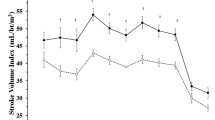Abstract
Heart rate is a function of at least three factors located in the sinus node, including the pacemaker and the activity of the sympathetic and vagal pathways. Heart rate varies during breathing and exercising. The is far from being a purely academic question because, after myocardial infarction or in cardiac insufficiency, reduced heart rate variability (HRV) represents the most valuable prognostic factor. HRV is usually considered index of the sympathovagal balance and is explored using time domain analysis, such as spectral analysis. Nevertheless, methods such as the Fast Fourier Transformation are not applicable to small rodents which have an unstable heart rate with asymmetric oscillations. Nonlinear methods show chaotic behavior under some conditions. A time and frequency domain method of analysis, the Wigner-Villé Transform, has been proposed for the study of HRV in both humans and small rodents, as a compromise between linear and nonlinear methods. We developed a method to quantify both arrhythmias and HRV in unanesthetized rodents. Such a method allows study of the relationship between the physiological parameters and the myocardial phenotype. Ventricular premature beats are more frequent in 16-month-old spontaneously hypertensive rats than in age-matched controls. In addition, HRV is attenuated in spontaneously hypertensive rats, as in compensatory cardiac hypertrophy in humans, and such attenuation is considered a prognostic index. Converting enzyme inhibition reduces in parallel arterial hypertension, cardiac hypertrophy, and ventricular fibrosis; it prevents ventricular premature beats and normalizes heart rate variability. It can be demonstrated that the incidence of ventricular premature beats is linked to the myocardial phenotype in terms of both cardiac hypertrophy and fibrosis. The two factors act as independent variables. HRV is correlated with the incidence of arrhythmias, suggesting that the beneficial effects of converting enzyme inhibition are related to prevention of arrhythmias.
Similar content being viewed by others
Author information
Authors and Affiliations
Additional information
Received: 30 September 1996 / Accepted: 23 January 1997
Rights and permissions
About this article
Cite this article
Swynghedauw, B., Jasson, S., Clairambault, J. et al. Myocardial determinants in regulation of the heart rate. J Mol Med 75, 860–866 (1997). https://doi.org/10.1007/s001090050177
Issue Date:
DOI: https://doi.org/10.1007/s001090050177




